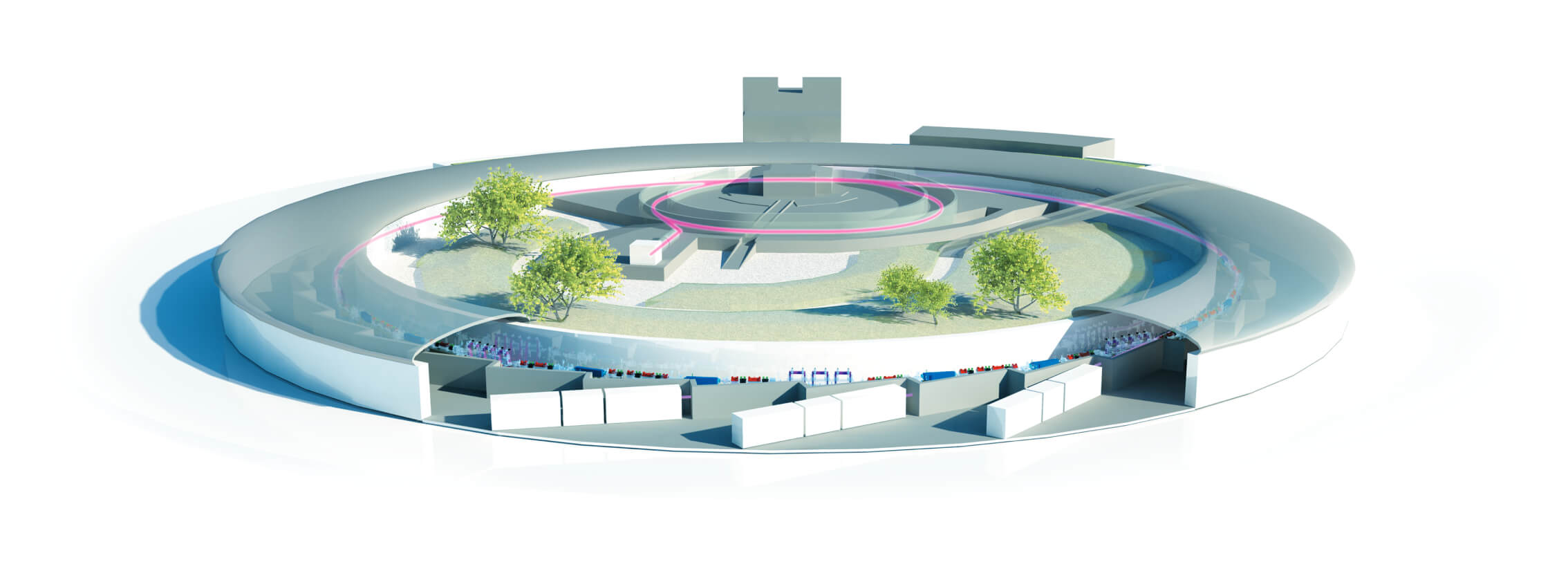About
STREAMLINE is a Horizon2020-funded project that will complement the ESRF-EBS upgrade by enhancing user operation through new procedures and systems. STREAMLINE is a grant worth 5 million Euros for which the ESRF is the sole beneficiary. STREAMLINE will run for 54 months, from 15 November 2019 to 14 May 2024.

In 2020, the ESRF’s Extremely Brilliant Source (ESRF-EBS), which is a 2018 ESFRI Roadmap Landmark, began user operation delivering the world’s first high-energy fourth-generation synchrotron.
The ESRF-EBS source upgrade provides X-ray beams with performances increased by a factor 100 in terms of brilliance and coherence, compared with third-generation synchrotrons. The enhanced X-ray beams, together with the most advanced portfolio of new beamlines and a “data-as-a-service” strategy, will allow completely new experiments as well as significant gains in resolution or rapidity for existing experiments. EBS therefore provides potential for increased capacity at the beamlines.
STREAMLINE will adapt the systems involved in user operation to make an increase in the number of user experiments possible. New services will be envisaged and automation at the beamlines will be used to allow high-throughput.
STREAMLINE also aims to promote the new opportunities for research to existing users and new scientific communities. Benefits will be felt by both academia and industry. This will allow the ESRF to become rapidly the first operational demonstrator of a high-energy fourth-generation synchrotron.
For more information about ESRF-EBS: www.esrf.eu/about/upgrade.
Work packages
WP1: Project management, communication, dissemination and exploitation
WP1 addresses the project coordination, management and dissemination activities of STREAMLINE. Within this work package there is provision for workshops to disseminate results of streamline to the European light source community.
WP2: Business plan and facility access policies
WP2 addresses the facility’s business plan and access policies in the context of the new scientific opportunities afforded by the new ESRF-EBS storage ring. WP2 is therefore the cornerstone of STREAMLINE’s overall sustainability objectives and planning for the ESRF. Its results will drive the remaining work packages.
The overall aim of WP2 is therefore to produce a sustainable business plan through a wide-ranging review of scientific opportunities with strong socio-economic impact (more details about this research project can be found by clicking the link below), whilst also building a tenable set of user administrative practices and access models, for academic and industrial researchers, compatible with the vastly increased ESRF-EBS capacities and the ESRF’s current, emerging and new user communities.
Assessing Socio-economic Impact of Research Infrastructures
This will undoubtedly involve extending the mail-in service, leveraging the experience of the existing mail-in service for structural biology.
WP3: Update user tools and administrative procedures
WP3 builds upon the strategic steering provided by WP2 and addresses the necessary adaptations to the ESRF’s user administrative frameworks and revisits the access models, industry charging models and KPI (key performance indicator) generation. A key element of this strategy will be the enlarged use of mail-in services for researchers from academia and industry.
This work package aims to increase user operation efficiency to match the new ESRF-EBS experimental capacity, making increased experimental throughput feasible. The challenge is two-fold, firstly to improve the capacity of the current systems to cope with EBS throughput, and secondly to effect a fundamental change in the way some users and communities carry out their experiments: increasing experimental efficiency and saving time for the scientists, thereby making experiments both more cost effective and time efficient.
WP4: Build capacity
WP4 seizes the opportunities for new experiment capacities. The ESRF-EBS will enable new experimental capacities – both in terms of wholly new experiments and in terms of throughput and volume of samples. WP4 will deliver enlarged capacity with new service designs supported by laboratory management information systems and on-line data analysis tools. An important aspect underpinning future developments is the application of machine learning to data collection and analysis, which could be particularly powerful (for example) in supporting higher speed data analysis to report results rapidly and inform experiment strategy whilst the samples are still at the ESRF.
The new services will be co-designed with interested parties from both academia and industry. These new services will lower the barriers of access for researchers by making the techniques more approachable and encouraging their access to become “routine” for regular users. For non-expert users, the new services should feel like any other analytical services and therefore the excellence of the ESRF should become accessible to new communities.
WP5: User engagement, training and outreach
WP5 addresses the outreach and training required for both academic and industrial researchers to most effectively exploit the scientific opportunities of the ESRF-EBS, and the new access methods and services developed within STREAMLINE. The tasks of WP5 address both existing user communities and new communities that will be identified within WP2.
Videos will be used extensively as a training method of particular interest to users and future users, encouraging them to learn about a beamline or particular technique in preparation for an experiment at the facility. This is especially pertinent for mail in services and remote access experiments where users need knowledge of the beamline and advice on sample preparation, and who will not receive hands-on training at the beamline. An “Ambassador Programme” will be run to permit ESRF staff to give presentations at Schools/Universities in European Member States targeting the younger generation to raise the awareness of the capabilities of X-ray experiments and to inspire take-up of STEM careers, eventually to become synchrotron users and even synchrotron staff. An “Insight Programme” will permit completely new users to join peer-reviewed user experiments that have been accepted for beam time, to acquire an immediate understanding of the challenges and opportunities offered by EBS beamlines. A wide range of workshops and forums for discussion will be held to nurture new and emerging communities – a central element of building long-term sustainability and extending the user base of the ESRF.
Presentation: An overview of STREAMLINE